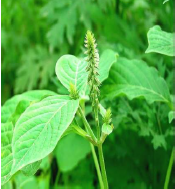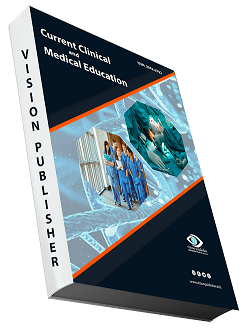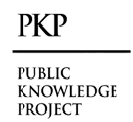Review of Pharmacognosticevalution and standardization of the plant achyranthus aspera: Phytochemical profile and antioxidant and Antimicrobial qualities
Keywords:
plant achyranthus aspera, Phytochemical, antioxidant, AntimicrobialAbstract
This study provides an extensive pharmacognostic evaluation and standardization of Achyranthus aspera, a traditional medicinal plant. The plant extracts were evaluated for their phytochemical composition of antioxidant activity and antibacterial activities. Phytochemical study listed biologically active compounds including alkaloid, flavonoid, saponin, and tannins ect. The extracts have an excellent anti-oxidant and anti-bacterial activity against a variety of illnesses. The plant extract was standardized using a physicochemical and analytical examination. The findings show that Achyranthus aspera has potential therapeutic uses, necessitating more research into its usage as a botanical medications in the prevention and treatment of illnesses.
Downloads
References
Srivastav S, Singh P, Mishra G, Jha K, Khosa R. Achyranthes aspera-An important medicinal plant: A review. JNat Prod Plant Resour [Internet]. 2011;1(1):1–14. Available from:https://www.scholarsresearchlibrary.com/articles/achyranthes-asperaan-important-medicinal-plant-a-review.pdf
Rashad M, Adil MA, Siddique MB, SohaibPeerzadah, Saadullah M. Antioxidant and Pharmacognostic Evaluationof Achyranthes Aspera: Therapeutic Potential and Analytical Validation of Secondary Metabolites. AustralianHerbal Insight [Internet]. 2024 Mar 15;7(1):1–14. Available from:https://www.researchgate.net/publication/383975069_Antioxidant_and_Pharmacognostic_Evaluation_of_Achyranthes_Aspera_Therapeutic_Potential_and_Analytical_Validation_of_Secondary_Metabolites.
Banerjee J, Prasanna Dahal. PHYTOCHEMICAL CONSTITUENTS AND PHARMACOLOGICAL USES OFMEDICINAL PLANT ACHYRANTHES ASPERA: World Journal of Pharmaceutical Research [Internet]. 2014Dec 16;4(1). Available from:https://www.researchgate.net/publication/277248219_PHYTOCHEMICAL_CONSTITUENTS_AND_PHARMACOLOGICAL_USES_OF_MEDICINAL_PLANT_ACHYRANTHES_ASPER
Sharan P, Madan VK. A brief review on the medicinal and phytochemical profiling of the Achyranthes asperaLinn. (Apamarga). ResearchGate [Internet]. 2018 Feb 19;7(2):890–5. Available from:https://www.researchgate.net/publication/340635261_A_brief_review_on_the_medicinal_and_phytochemical_profiling_of_the_Achyranthes_aspera_Linn_Apamarga
Shukla A, Bukhariya V, Bajaj J, Charde R. ACHYRANTHES ASPERA LINN. (CHIRCHIRA): A MAGICHERB IN FOLK MEDICINE. International Journal of Biomedical and Advance Research. 2011 Oct 9;2(6).
N.G. Sutar, U.N. Sutar, Sharma YP, Shaikh IK, S.S. Kshirsagar. Phytochemical investigation andpharmacological screening of leaves of Achyranthus aspera Linn. as analgesic and antipyretic. BiosciencesBiotechnology Research Asia [Internet]. 2016 Apr 23 [cited 2024 Dec 6];5(2):841–4. Available from:https://www.biotech-asia.org/vol5no2/phytochemical-investigation-and-pharmacological-screening-of-leaves-of-achyranthus-aspera-linn-as-analgesic-and-antipyretic/
WorkinehShibeshi, Makonnen E, LegesseZerihun, Debella A. Effect of Achyranthes aspera L. on fetal abortion,uterine and pituitary weights, serum lipids and hormones. African Health Sciences [Internet]. 2006 Jun1;6(2):108–12. Available from:https://www.researchgate.net/publication/6872216_Effect_of_Achyranthes_asea_L_on_fetal_abortion_uterine_and_pituitary_weights_serum_lipids_and_hormones
Senthil Kumar Raju, Shridharshini Kumar, Praveen Sekar, Maruthamuthu Murugesan, Mohanapriya Karthikeyan,Anjana Elampulakkadu, et al. A comprehensive review on phytochemistry of Achyranthes aspera Linn.: AnIndian medicinal plant. World Journal of Advanced Research and Reviews. 2022 May 30;14(2):057–67.
Fikru A, Makonnen E, Eguale T, Debella A, Abie Mekonnen G. Evaluation of in vivo wound healing activity ofmethanol extract of Achyranthes aspera L. Journal of Ethnopharmacology. 2012 Sep;143(2):469–74.10.Tahiliani P, Kar A. Achyranthes aspera elevates thyroid hormone levels and decreases hepatic lipid peroxidationin male rats. Journal of Ethnopharmacology. 2000 Aug;71(3):527–32
Vetrichelvan T, Jegadeesan M. Effect of alcohol extract of Achyranthes aspera Linn. on acute and subacuteinflammation. Phytotherapy Research. 2003 Jan;17(1):77–9.
Dwivedi S, Dubey R, Mehta K. Achyranthes aspera Linn. (Chirchira): A Magic Herb in Folk Medicine. 2008 Jan1;12. Available from:https://www.researchgate.net/publication/41115502_Achyranthes_aspera_Linn_Chirchira_A_Magic_Herb_in_Folk_Medicine
Santosh Patil H, Pachpol V, JivandasGadilohar R, Khalikuzzama Q, Patil S. A Review on AchyranthesAspera: A Traditional Medicinal Plant. International Journal of Research Publication and Reviews Journalhomepage: wwwijrprcom [Internet]. 2023 [cited 2024 Dec 13];4:276–88. Available from:https://ijrpr.com/uploads/V4ISSUE7/IJRPR15242.pdf
The Wealth of India: A Dictionary of Indian Raw Materials and Industrial Products (Industrial Products—Part I).The Indian Medical Gazette [Internet]. 1949 Oct;84(10):476. Available from:https://pmc.ncbi.nlm.nih.gov/articles/PMC5189551/
Srivastava PK. ACHYRANTHES ASPERA: A POTENT IMMUNOSTIMULATING PLANT FORTRADITIONAL MEDICINE. International Journal of Pharmaceutical Sciences and Research [Internet]. 2014Mar 6;5(5):11. Available from:https://www.researchgate.net/publication/262818015_ACHYRANTHES_ASPERA_A_POTENT_IMMUNOSTIMULATING_PLANT_FOR_TRADITIONAL_MEDICINE
Ndhlala AR, Ghebrehiwot HM, Ncube B, Aremu AO, Gruz J, Šubrtová M, et al. Antimicrobial, AnthelminticActivities and Characterisation of Functional Phenolic Acids of Achyranthes aspera Linn.: A Medicinal PlantUsed for the Treatment of Wounds and Ringworm in East Africa. Frontiers in Pharmacology. 2015 Nov 23;6.
Bagavan A, Rahuman AA, Kamaraj C, Geetha K. Larvicidal activity of saponin from Achyranthes aspera againstAedes aegypti and Culex quinquefasciatus (Diptera: Culicidae). Parasitology Research. 2008 Apr 6;103(1):223–9.
IJRPP Journal. Anti microbial activity of Ocimumbasilicum and Achyranthes aspera [Internet]. Academia.edu.2015. Available from:https://www.academia.edu/12002282/Anti_microbial_activity_of_Ocimum_basilicum_and_Achyranthes_aspera
Ndhlala AR, Ghebrehiwot HM, Ncube B, Aremu AO, Gruz J, Šubrtová M, et al. Antimicrobial, AnthelminticActivities and Characterisation of Functional Phenolic Acids of Achyranthes aspera Linn.: A Medicinal PlantUsed for the Treatment of Wounds and Ringworm in East Africa. Frontiers in Pharmacology. 2015 Nov 23;6.
Ida Y, Satoh Y, Katsumata M, Nagasao M, Hirai Y, Kajimoto T, et al. Two novel oleanolic acid saponins having asialyl Lewis X mimetic structure from Achyranthesfauriei root. Bioorganic & Medicinal Chemistry Letters[Internet]. 1998 Nov 16;8(18):2555–8. Available from:https://www.sciencedirect.com/science/article/abs/pii/S0960894X98004570
Bhosale U, Pophale P, Somani R, Yegnanarayan R. Effect of aqueous extracts of Achyranthes aspera Linn. onexperimental animal model for inflammation. Ancient Science of Life. 2012;31(4):202.
Pakistan Journal of Pharmaceutical Sciences [Internet]. 2020 Jan 1 [cited 2024 Dec 16];33(1). Available from:https://openurl.ebsco.com/EPDB%3Agcd%3A13%3A25819197/detailv2?sid=ebsco%3Aplink%3Ascholar&id=ebsco%3Agcd%3A142858984&crl=c&link_origin=scholar.google.co.in
Edwin S, Jarald EE, Deb L, Jain A, Kinger H, Dutt KR, et al. Wound Healing and Antioxidant ActivityofAchyranthes aspera. Pharmaceutical Biology. 2008 Jan;46(12):824–8.
Singh M, Govindarajan R, Nath V, Rawat AKS, Mehrotra S. Antimicrobial, wound healing and antioxidantactivity of PlagiochasmaappendiculatumLehm. et Lind. Journal of Ethnopharmacology. 2006 Aug;107(1):67–72.
Mukherjee PK, Verpoorte R, Suresh B. Evaluation of in-vivo wound healing activity of Hypericum patulum(Family: Hypericaceae) leaf extract on different wound model in rats. Journal of Ethnopharmacology. 2000Jul;70(3):315–21.
Ishtiaq A, Muhammad I, Barkatullah, Naveed M, Zahir M, Niaz A. Pharmacognostic and hypoglycemic studies ofAchyranthus aspera L. Journal of Pharmacognosy and Phytotherapy. 2013 Jul 31;5(7):127–31.
Medicinal plants of India / [editors, G. V. Satyavati, M. K. Raina, M. Sharma] - Catalogue | National Library ofAustralia [Internet]. Nla.gov.au. 2024 [cited 2024 Dec 16]. Available from:https://catalogue.nla.gov.au/catalog/2432502
Vasudeva RY, Duddukuri GR, Sunil BG, Athota RR. Immunomodulatory Activity of Achyranthes aspera on theElicitation of Antigen-Specific Murine Antibody Response. Pharmaceutical Biology. 2002 Jan;40(3):175–8.
Chakrabarti R, Vasudeva RaoY. Achyranthes aspera stimulates the immunity and enhances the antigen clearancein Catlacatla. International Immunopharmacology. 2006 May;6(5):782–90.
Sharma V, Chaudhary U. AN OVERVIEW ON INDIGENOUS KNOWLEDGE OF ACHYRANTHES ASPERA.2015 Jan 1;2(1):7–19. Available from:https://www.researchgate.net/publication/271139355_AN_OVERVIEW_ON_INDIGENOUS_KNOWLEDGE_OF_ACHYRANTHES_ASPERA
Chandana Choudhury Barua, Talukdar A, Shameem Ara Begum, Pathak DC, Sarma DK, Borah RS, et al. Invivowound-healing efficacy and antioxidant activity ofAchyranthesasperain experimental burns. PharmaceuticalBiology. 2012 Jun 7;50(7):892–9.
Haslam E. Natural Polyphenols (Vegetable Tannins) as Drugs: Possible Modes of Action. Journal of NaturalProducts. 1996 Jan;59(2):205–15.
Cowan MM. Plant Products as Antimicrobial Agents. Clinical Microbiology Reviews. 1999 Oct 1;12(4):564–82.
Cushnie TPT, Cushnie B, Lamb AJ. Alkaloids: An overview of their antibacterial, antibiotic-enhancing andantivirulence activities. International Journal of Antimicrobial Agents. 2014 Nov;44(5):377–86.
Tiwari SK, Jaiswal S, Srivastava V, Shreya Maddhesiya, Verma NK. IJMPR A Brief Study on AchyranthesAspera: A Review [Internet]. 2023. Available from:https://www.researchgate.net/publication/372647270_IJMPR_A_Brief_Study_on_Achyranthes_Aspera_A_Review
Khanbabaee K, Van Ree T. Tannins: Classification and Definition. Available from:https://pdfs.semanticscholar.org/f567/4bf4261292bccd96ac2c351779f385d7021e.pdf
Yadav R, Rai R, Yadav A, Pahuja M, Solanki S, Yadav H. Evaluation of antibacterial activity of Achyranthesaspera extract against Streptococcus mutans: An in vitro study. Journal of Advanced Pharmaceutical Technology& Research. 2016;7(4):149.
Hasan S. PHARMACOLOGICAL AND MEDICINAL USES OF ACHYRANTHES ASPERA. 2014 Feb2;3(1):123–9. Available from:https://www.researchgate.net/publication/260983682_PHARMACOLOGICAL_AND_MEDICINAL_USES_OF_ACHYRANTHES_ASPERA
Paul D, De D, Ali KM, Chatterjee K, Ghosh D. Comparative study on the spermicidal activity of organic solventfractions from hydroethanolic extracts of Achyranthes aspera and Stephania hernandifolia in human and rat sperm.Contraception [Internet]. 2010 Apr 1;81(4):355–61. Available from:https://www.researchgate.net/publication/41943074_Comparative_study_on_the_spermicidal_activity_of_organic_solvent_fractions_from_hydroethanolic_extracts_of_Achyranthes_aspera_and_Stephania_hernandifolia_in_human_and_rat_sperm
Krishnaveni A, Thaakur SR. Pharmacognostical and preliminary phytochemical studies of achyranthes asperalinn. Ancient science of life [Internet]. 2006 Jul;26(1-2):1–5. Available from:https://pubmed.ncbi.nlm.nih.gov/22557217/
Singh N. A Review on Pharmacological Aspects of Achyranthes Aspera. International Journal of Pharmacognosy& Chinese Medicine. 2019;3(4):1–10.
Ejikeme CM, Ezeonu CS, Eboatu AN. DETERMINATION OF PHYSICAL AND PHYTOCHEMICALCONSTITUENTS OF SOME TROPICAL TIMBERS INDIGENOUS TO NIGER DELTA AREA OFNIGERIA. 2014 Jul 1;10(18):1857–7881. Available from:https://www.researchgate.net/publication/277714662_DETERMINATION_OF_PHYSICAL_AND_PHYTOCHEMICAL_CONSTITUENTS_OF_SOME_TROPICAL_TIMBERS_INDIGENOUS_TO_NIGER_DELTA_AREA_OF_NIGERIA
Rabi T, Bishayee A. Terpenoids and breast cancer chemoprevention. Breast Cancer Research and Treatment. 2008Jul 19;115(2):223–39.
Sultana N, Ata A. Oleanolic acid and related derivatives as medicinally important compounds. Journal of EnzymeInhibition and Medicinal Chemistry. 2008 Jan 1;23(6):739–56.
Verma N, Singh A, Singh V. Reply. Hepatology. 2018 Jul;68(1):388–8.
Singh S, Singh A, Navneet, Srivastava V. Ethnobotanical and Pharmacological Benefits of Achyranthes asperaLinn.: An overview. International Journal of Pharmaceutical Sciences Review and Research [Internet]. 2018 Feb20 [cited 2024 Dec 15];48(2 018):1–7. Available from:
Kishore Kumar Kadimpati, Naidu PVL, Kumar CM, G. Gunesh, Rao MN. Antimicrobial activity of Achyranthesaspera. 2006 Jul 15;3(2):171–4. Available from:https://www.researchgate.net/publication/262933223_Antimicrobial_activity_of_Achyranthes_aspera
Halliwell B. Antioxidants in human health and disease. Annual review of nutrition [Internet]. 1996;16:33–50.Available from: https://www.ncbi.nlm.nih.gov/pubmed/8839918

Downloads
Published
How to Cite
Issue
Section
License

This work is licensed under a Creative Commons Attribution 4.0 International License.
Current Clinical and Medical Education













